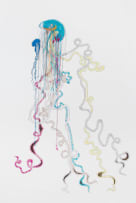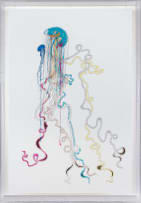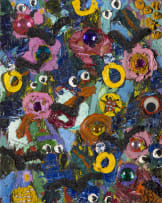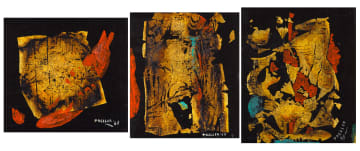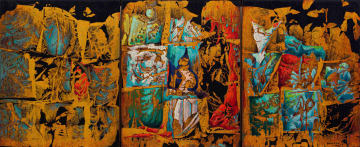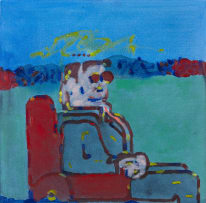Evening Sale: Modern and Contemporary Art
Live Virtual Auction, 19 September 2023
Modern and Contemporary Art
About this Item
signed, dated 2015 and inscribed with the title on the reverse; inscribed with the artist's name, the date and the title on a South African National Gallery label adhered to the reverse
Notes
Nicholas Hlobo works with a diverse store of materials, including ribbon, leather, wood, rubber and copper, which he variously melds and weaves together to create two- and three-dimensional hybrid objects. Each material holds a particular association for the artist and is linked to his exploration of gender, race, ethnicity and language in relation to the artist's Xhosa heritage and gay identity. Best known for his free-form sculptures, Hlobo has also produced a large number of canvas- and paper-based works in the style of this lot.
'Calling these 'drawings' or 'paintings' is a misnomer because in general they generate no surface marks with paint or other conventional graphic tools,' writes artist and curator Gavin Jantjes. 'One cannot speak of graphic lines or shading. Images on paper or canvas behold a sculptural attitude that adds spatial dimensions. They are tailored into existence through splits, tears, collage, applique and the cross hatching of thread. The veneer of the picture plane is punctured, split and perforated. Crossstitched and crochet lever his images into a third dimension. The surface lifts and recedes to create natural shadows and highlights in low relief.'1
Although prone to working in an allusive manner, Hlobo's works often have a figural reference or invoke idiomatic phrases linked to cultural practices from his youth. His works have often been likened to jellyfish - a point of view repeated when this lot was exhibited at Museum Beelden aan Zee, a seaside sculpture museum in Holland. 'The idea of a sea animal is reflected in Ityhengetyhenge, where the surface of the linen is cut open and largely stitched back together in the form of a colourful jellyfish or a colony animal such as the Portuguese man-of-war,' wrote art critic Bertus Pieters. 'The skin of the creature becomes, as it were, one with the surface of the relief and thus the creature becomes one with its environment. It affects its environment as the environment affects it.'2
The role of the stitch is integral to the meaning of works in this style, and operates in conjunction with any particular reference or context specific to an individual work.
'Given the history of this country, the process of trying to rebuild a new culture gives the stitch a metaphorical quality,' explained the artist. 'It's almost as if we are stitching bits and pieces of history together to build something new. I choose to employ techniques and methods that many people consider primitive. An Italian curator visiting my studio said the work is very craft-oriented. This is deliberate, I am telling an African story. I enjoy my interference with the material, not using an artificial tool like a camera or having the material laser-cut. It is my way of inserting myself into that object, of putting my soul into it.'3
This lot was included in the important exhibition Women's Work: Crafting Stories, Subverting Narratives, which aimed to highlight 'the permeable boundary between 'fine art' and 'craft' practices and to question the perceptions about gender roles implicated in the 'fine art' and 'craft' divide'.4 It appeared in a room devoted to 'transgressive materiality' that also featured an earlier work in this style, Isisele (2010), as well as works by other major textile artists Igshaan Adams and Liza Lou.
1. Gavin Jantjes (2011) Nicholas Hlobo: Sculpture, Installation, Performance, Drawing, Oslo, National Museum of Art, Architecture and Design, page 67.
2. Bertus Pieters (2016), 'A presence; Nicholas Hlobo: Imilonji Yembali / Melodies of History, Museum Beelden aan Zee, The Hague,' Villa La Repubblica, 4 March: https://villalarepubblica. wordpress.com/2016/03/04/ een-aanwezigheid-nicholas-hloboimilonji- yembali-melodies-of historymuseum- beelden-aan-zee-den-haag/
3. Sean O'Toole (2011) 'Interview with Nicholas Hlobo', in The World Belongs to You, Venice/ Milan, Palazzo Grassi and Electa, page 119.
4. Ernestine White and Olga Speakes (2016), Wall text Women's Work: Crafting Stories, Subverting Narratives, Iziko South African National Gallery, Cape Town.
Exhibited
De 11 Lijnen, Belgium, Literated Subjects - Present Tense, 19 April to 11 July 2015.
Museum Beelden aan Zee, Netherlands, Nicholas Hlobo: Imilonji Yembali (Melodies of History), 12 February to 16 May 2016.
South African National Gallery, Cape Town, Womens Work: crafting stories, subverting narratives, 2017.

